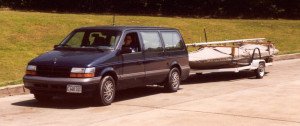Trailer
Trailer Bunks
Measurements for the shape of the bunks can be calculated from the boat plans once you know the two spots on the boat that will rest on the bunks (front and back are not the same!). Alternatively, you can simply copy the existing bunks if they fit well.
Cover the bunks with carpet. Don’t use nails or staples on the surface where the boat will sit or you will have gouges in your bottom.


Tie Downs
Tie downs can be attached to the trailer with webbing straps and tightening levers (shown) or with turnbuckles. Whatever system is chosen, make sure that the tie downs can’t shift while driving—they both keep the boat on the trailer and support the mast and boom.
Use bungee cords or Velcro straps to hold the mast and boom to the tie downs.
Extra reflectors on the trailer (under the boat, on the sides, on the tie downs) make your trailer much more visible after dark. Some states even require a light on the end of the mast depending on how far it extends back beyond the boat.


Lights
Putting the lights on the tie-downs keeps them out of the water if you back your boat down a ramp. Keep the connector wire loose and run it down the length of the mast when trailering (attach with electrical or duct tape sticky side out so that you don’t get tape residue on the mast. You can build custom “rests” for your mast and boom to sit in, but it is not necessary.

Extra Mast Support
Some people add an extra support for the mast on the front of the trailer, as shown below. Others use only a rear tie-down and a high front support so that the mast rides at an angle and is out of the way of rear van doors.
Note also the location of the spare tire.

Spare Tire
A slightly different place to store the spare tire. Note also the tongue wheel to support the front end of the trailer when it’s not attached to a vehicle.

Guide Bars
If you usually ramp your boat into the water, guide bars make it much easier to get your boat back on the trailer straight—even in a vicious cross wind.
If you ramp a lot, bearing buddies will help keep the grease in your wheel bearings. Still, it’s smart to check your bearings frequently—particularly if you are in salt water.

Top/Bottom Covers
If you travel a lot, trailering top and bottom covers can be a worthwhile investment to avoid all the road dirt and chips that your boat will otherwise pick up. Fenders will also help keep your boat (or cover) cleaner.

Keep Bailers Open
Be sure to open the bailers in the boat whenever you are trailering (or even if the boat is just sitting on the trailer). Otherwise, rain will collect in the boat and both add to the load you’re towing and cause it to be harder to control in turns and when braking. Don’t forget to close them when launching!
